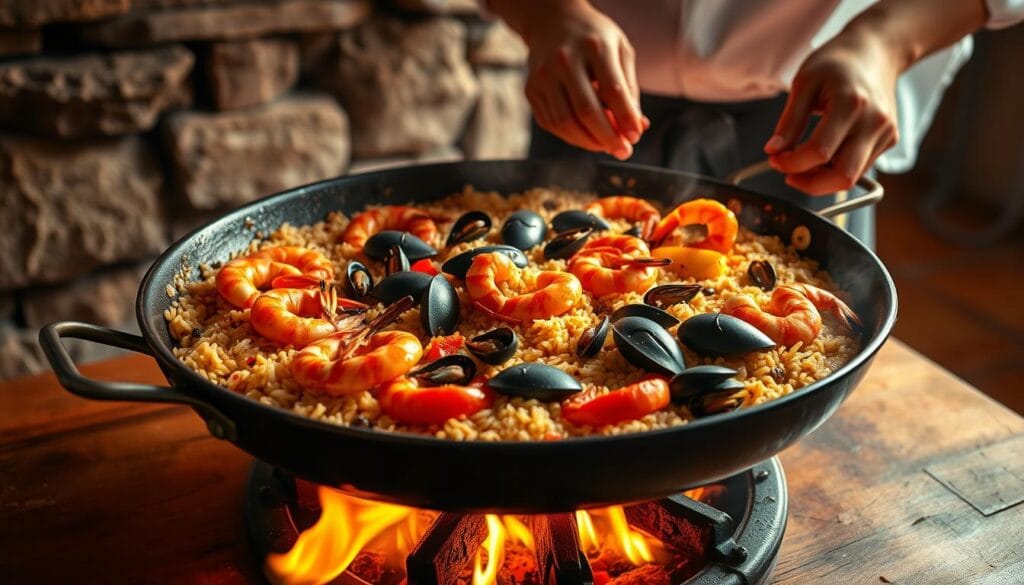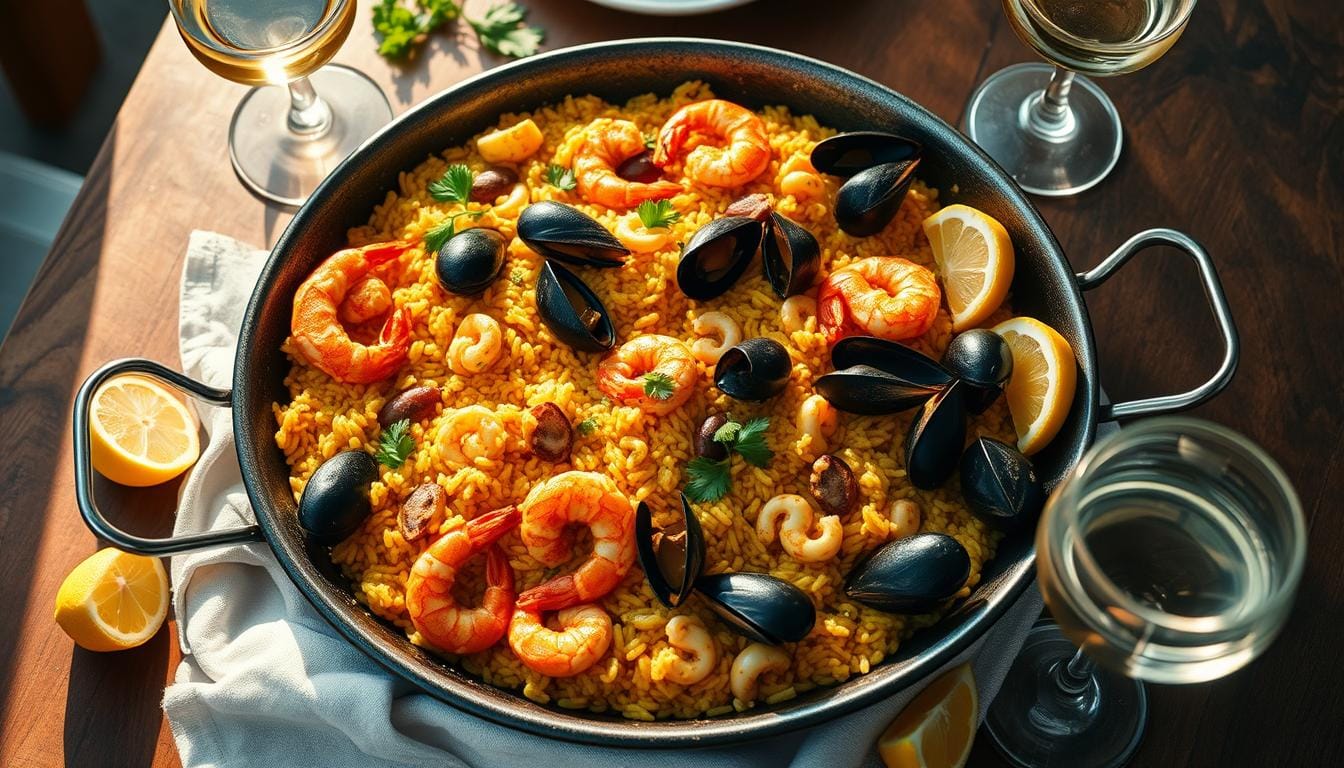How to Make an Authentic Seafood Paella Dish
The first time I tasted seafood paella in a small coastal restaurant in Valencia, I knew it was special. The vibrant colors and the rich aroma of saffron were amazing. The perfectly cooked seafood made it a culinary experience like no other.
Spanish paella is more than a dish; it’s a celebration of flavor, tradition, and community. This iconic seafood paella shows the heart of Spanish cuisine. It combines fresh ingredients with old cooking techniques to create a remarkable meal.
Whether you love cooking at home or are a culinary adventurer, making authentic seafood paella is a journey. It will open a world of rich flavors and cultural heritage. Get ready to improve your cooking and impress your guests.
Table of Contents
Understanding the Origins of Traditional Spanish Paella
Spanish paella has a humble start, tied to Valencia’s agricultural land. It began as a meal for farm workers in the 14th and 15th centuries. Over time, it grew into a beloved national dish.
The story of paella shows Spanish culinary creativity. It was cooked over log fires during breaks. Valencian farmers made it with local ingredients, creating a hearty meal.
History of Valencian Paella
Valencia’s coast is where paella was born. By the late 18th century, it reached all over Spain. Today, the Valencian government protects its traditional making.
- Originated in 14th-15th centuries
- Prepared by farm laborers
- Cooked traditionally over open fires
- Protected by Valencian government since 2021
Cultural Significance in Spanish Cuisine
Paella went beyond its farm origins to symbolize Spanish food culture. It’s a dish of comunidad (community). It’s shared at family gatherings and celebrations.
Regional Variations and Authenticity
The original Valencian recipe has ten key ingredients like chicken and rabbit. Coastal areas added seafood, making paella richer. This change came from the Valencian coast and Balearic Islands.
Now, paella keeps growing, showing Spain’s food diversity. Yet, it stays true to its traditional roots.
Essential Ingredients for Seafood Paella
To make a real seafood paella, you need the right ingredients. They add depth, flavor, and a taste of Spain’s coast. Knowing what to use makes your paella truly special.
Types of Seafood to Use
For a great seafood paella, use only the freshest seafood. The best mix includes:
- Large shrimp (12 pieces)
- Fresh mussels (14 cleaned)
- Clams (14 well-drained)
- Firm white fish like halibut or snapper (1 lb)
Selecting the Right Rice
The heart of seafood paella is the rice. Bomba rice is the best choice. It soaks up broth like no other, keeping your dish flavorful and just right.
Spices and Aromatics
The magic of seafood paella comes from its spices. Saffron, the priciest spice, gives it a golden color and deep taste. Other key spices include:
- 8 minced garlic cloves
- 3 teaspoons smoked paprika
- Fresh herbs: cilantro, basil, scallions
- Seeded, chopped Roma tomatoes
| Ingredient | Quantity | Purpose |
|---|---|---|
| Dry Arborio Rice | 2 cups | Primary starch base |
| Chicken Broth | 4-4¼ cups | Liquid for cooking rice |
| Clam Juice | 2 cups | Additional flavor depth |
| Salted Butter | 4 tablespoons | Richness and flavor |
Pro tip: Choose the freshest ingredients for the best seafood paella. It makes for a memorable meal.
Required Equipment and Tools
To make a real seafood paella, you need special tools. The main piece is the paellera, a special pan. It’s made just for paella and helps your dish turn out great.
When picking your paella pan, think about a few things:
- Pan Size Options:
- 14-inch carbon steel pan serves 3-6 people
- 16-inch stainless steel pan accommodates 4-6 guests
- 20-inch carbon steel pan handles up to 14 servings
- Material Considerations:
- Carbon steel: Rapid, even heating
- Enameled steel: Rust-resistant, budget-friendly
- Copper: Superior heat conductivity
You’ll also need other important tools for your paella:
- Heat source (gas burner, stovetop, or outdoor grill)
- Wooden spoon or spatula
- Measuring cups
- Kitchen towel for covering
When buying a paella pan, spend about $20 per person. Choose pans with two riveted loop handles for easy carrying. A tip: Season your carbon steel pan at 350 degrees Fahrenheit for the best results in making seafood paella.
Preparing the Seafood Components
Starting an authentic seafood paella means preparing your seafood well. Fresh seafood makes your dish special, adding lots of flavor and texture.
For your paella, focus on shrimp, mussels, and squid. Each needs special cleaning and prep to get the best taste in your seafood dish.
Cleaning and Deveining Shrimp
For top seafood paella, use jumbo peeled and deveined tail-on Gulf shrimp. Here’s how to prepare them:
- Rinse shrimp under cold water
- Pat dry with paper towels
- Remove dark vein running along the back
- Keep tails intact for visual appeal
Preparing Mussels and Clams
Choose fresh Greenshell mussels and prepare them carefully:
- Inspect mussels for any damage
- Remove beard by pulling towards the hinge
- Discard any open or damaged mussels
- Rinse thoroughly under cold water
Cutting and Cleaning Squid
To make an authentic seafood paella, prepare your squid right:
- Remove inner cartilage
- Clean thoroughly under running water
- Cut into rings approximately 1/2 inch thick
- Pat dry before cooking
Pro tip: Buy seafood from a trusted source and use it within 1-2 days for the best taste in your seafood paella.
Creating the Perfect Seafood Paella Base
Making a great spanish paella starts with a rich, flavorful base. This base is key to a delicious dish. It’s all about the right ingredients and cooking methods.
Begin by making your aromatic base with these important parts:
- 8 finely chopped garlic cloves
- 2 ripe tomatoes, blended into a smooth sauce
- 1 teaspoon smoked paprika
- 2 dried ñora peppers (or 2 teaspoons dried pepper flakes)
The secret to amazing seafood paella is in how you cook these ingredients. Use 120ml of premium Spanish extra virgin olive oil. This oil adds a deep, Mediterranean flavor to your dish.
| Ingredient | Quantity | Preparation |
|---|---|---|
| Garlic | 8 cloves | Finely chopped |
| Tomatoes | 2 whole | Blended |
| Saffron | 0.4g | Gently toasted |
To make your base, heat the olive oil and sauté the garlic until it smells great. Then, add the tomatoes and spices. Let them simmer until the flavors are strong. This makes your seafood paella truly special.
Pro tip: Use 3 litres of shellfish stock for the best flavor. The Bomba D.O. Spanish paella rice soaks up lots of flavor. It makes your dish just right.
The Art of Cooking Authentic Seafood Paella
Mastering seafood paella needs precision, technique, and patience. It’s more than a dish; it’s a culinary art form. It demands careful attention and respect for traditional cooking methods.

To make an exceptional seafood paella, you must understand key cooking principles. These principles turn this Spanish classic into a memorable dining experience.
Layering Ingredients with Precision
When making your seafood paella, use these layering techniques:
- Begin with a base of sofrito (onions, garlic, tomatoes)
- Add seafood strategically for even cooking
- Distribute rice evenly across the pan
- Make sure each ingredient touches the pan
Managing Heat and Timing
Heat management is key for authentic Spanish paella. Follow these temperature guidelines:
| Cooking Stage | Temperature | Duration |
|---|---|---|
| Initial Searing | Medium-High | 5-7 minutes |
| Rice Cooking | Medium-Low | 18-20 minutes |
| Final Resting | No Heat | 5-10 minutes |
Achieving the Perfect Socarrat
The socarrat—that coveted crispy rice bottom—is the hallmark of an exceptional seafood paella. To achieve this, use these expert techniques:
- Use high-quality paella pan
- Maintain consistent medium-low heat
- Listen for a subtle crackling sound
- Watch for golden-brown coloration
Remember, creating an authentic seafood paella takes practice. Each attempt brings you closer to mastering this beloved Spanish culinary tradition.
Common Mistakes to Avoid When Making Paella
Making a real seafood dish paella needs skill and care. Many people mess up their paella by making big mistakes. These mistakes can ruin the taste and feel of the dish.
There are key mistakes to watch out for when making seafood paella. Knowing these can help you make a better and tastier dish.
- Rice Selection Errors: Using regular long-grain rice instead of Spanish rice like Bomba or Calasparra can mess up your paella. These special rices soak up a lot of liquid but stay fluffy.
- Stirring Temptation: Don’t stir your paella after adding the ingredients. Stirring can break the rice and stop the socarrat – the crispy bottom layer – from forming.
- Seafood Cooking Mistakes: Cooking seafood too long makes it tough and rubbery. This messes up the dish’s flavor balance.
Experts say to keep the heat steady and not overcrowd the pan. It’s better to use high-quality ingredients than a lot of them in your seafood dish paella.
| Mistake | Consequence | Solution |
|---|---|---|
| Wrong Rice | Mushy or Hard Texture | Use Bomba or Calasparra Rice |
| Overstirring | Broken Rice Grains | Let Rice Cook Undisturbed |
| Overcooking Seafood | Tough, Rubbery Texture | Cook Seafood Briefly at High Heat |
By avoiding these common mistakes, you’ll be well on your way to creating a spectacular seafood paella. It will truly capture the essence of traditional Spanish cuisine.
Serving and Presentation Tips
Your seafood paella should look as good as it tastes. A stunning presentation can turn a simple meal into a memorable experience. It’s all about capturing the essence of Spanish cuisine.

Seafood paella is best served straight from the pan. This method adds to the dish’s warmth and beauty. It also makes the meal feel more communal and inviting.
Traditional Garnishes
Enhance your seafood paella with these classic garnishes:
- Fresh lemon wedges
- Chopped parsley
- Homemade aioli
- Additional fresh herbs
Recommended Side Dishes
Pair your spanish paella with these tasty sides:
- Crusty artisan bread
- Light green salad with vinaigrette
- Roasted vegetables
- Chilled white wine
Timing is key when serving paella. Try to get it to the table right after cooking. This way, the dish stays warm and the socarrat – the crispy rice layer – stays perfect.
Conclusion
Making authentic seafood paella is more than cooking. It’s about connecting with a rich tradition from Valencia, Spain. Your journey shows you’re part of a long line of cooks who made simple ingredients special.
Keep honing your seafood paella skills. Each time you cook, you tell a new story. The crispy socarrat, the seafood, and the rice show your growing skill. Feel free to try new things, but always keep the tradition in mind.
Seafood paella is about sharing and celebrating. It’s perfect for family gatherings or dinner parties. Cook it with pride, pair it with Albariño wine, and enjoy the fruits of your labor.


